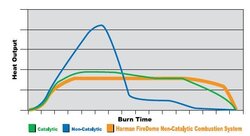So, this is an honest question from a cat stove owner to all the experienced non-cat stovers out there. It's not a "cat vs. non-cat" debate, or any attempt to insult or compare one technology to the other. It's a simple, "I'd like to buy one of those pretty non-cat stoves, but don't understand how the heck one heats a house with those things," kind of question.
I've never burned a non-cat stove, but here's a list of information I've collected or deduced, correct or assumed. Please tell me where I'm right, and where I'm wrong!
1. Non-cat stoves must be burned with the firebox temp at or above 1100*F to keep the secondary burn active. If firebox temperatures fall below 1100F, the secondary burn fails. It's not clear how much creosote one is producing after the secondaries go out of ignition.
2. The famous Harmon Firedome graph:

To someone who's never operated a non-cat, it sure appears your stove is going to hit 10x it's "cruising temperature" in the first 1/3 of the burn. It also appears that maybe the secondary burn lasts only half the burn cycle.
3. A non-cat stove requires the operator to adjust the air control several times during the burn cycle to minimize temperature swings, and maintain the longest possible secondary burn.
4. Due to the high temperatures produced in the first half of the burn cycle, non-cat stoves must be properly sized (not too big or too small) for an application.
5. If one's goal is to load the stove twice a day and keep an empty house at a relatively cool 62*F for 20 hours per day, then heating to 68*F or 70*F for 4 hours each evening, a non-cat stove may not be up to the challenge.
Again, I'm hoping that I'm wrong on nearly all of these statements, but they were gathered (or perhaps incorrectly inferred) by things said here by those more experienced than I.
I've never burned a non-cat stove, but here's a list of information I've collected or deduced, correct or assumed. Please tell me where I'm right, and where I'm wrong!
1. Non-cat stoves must be burned with the firebox temp at or above 1100*F to keep the secondary burn active. If firebox temperatures fall below 1100F, the secondary burn fails. It's not clear how much creosote one is producing after the secondaries go out of ignition.
2. The famous Harmon Firedome graph:

To someone who's never operated a non-cat, it sure appears your stove is going to hit 10x it's "cruising temperature" in the first 1/3 of the burn. It also appears that maybe the secondary burn lasts only half the burn cycle.
3. A non-cat stove requires the operator to adjust the air control several times during the burn cycle to minimize temperature swings, and maintain the longest possible secondary burn.
4. Due to the high temperatures produced in the first half of the burn cycle, non-cat stoves must be properly sized (not too big or too small) for an application.
5. If one's goal is to load the stove twice a day and keep an empty house at a relatively cool 62*F for 20 hours per day, then heating to 68*F or 70*F for 4 hours each evening, a non-cat stove may not be up to the challenge.
Again, I'm hoping that I'm wrong on nearly all of these statements, but they were gathered (or perhaps incorrectly inferred) by things said here by those more experienced than I.


 I posted in the Wood Shed. Idiot.
I posted in the Wood Shed. Idiot. 


